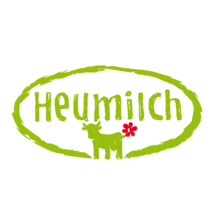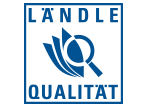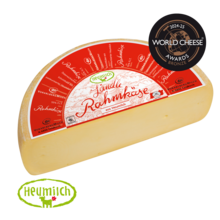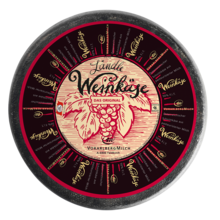
Vorarlberger Bergkäse
Origin protected within the EU
If you are familiar with the beauty of Vorarlberg (Austria), you’ll see it is quite obvious that the best natural “Ländle” milk comes from this region. Vorarlberger Bergkäse, made from raw milk, is a cheese with tradition and an EU protected designation of origin. During the 6-month maturation period in a natural cellar, it develops its distinct brownish natural rind.
A cheese like a stroll in spring. The scent of citrus fruits, malt, honey and walnut will fill your nose. The impression on the palate is light aromatic and unobtrusive with hints of sour cream, citrus, flowering meadow and toasted white bread. This firm and creamy cheese feels elegant. The smooth and rich sensation it leaves on your lips highlights the tantalizing taste of the cheese.
Characteristics:
Raw material: Ländle haymilk, raw milk, non-GMO
Maturation period: min. 4–10 months
Cheese rind: distinctly brownish
Cheese colour/holes: buttery yellow; occasional pea-sized holes
Cheese texture/flavour: firm and creamy, typical
Fat i.d.m.: Hard cheese, 45% fat i.d.m.
Designation of origin protected within the EU.

Vorarlberg: the home of top-quality milk
The cows of the Margreitter farm in Vorarlberg’s idyllic Klostertal valley spend the summer high up in the Alps, enjoying the lush grasses in the meadows. This is where the best milk is made – the only kind that goes into our unique Vorarlberger Bergkäse.

Multiple generations sharing a farm
Helga and her husband Thomas run the Margreitter farm in Radin near Bludenz. Their son Florian is the deputy head of Vorarlberg Milch and will be taking over the farm soon.
Quality starts with the animals’ well-being
Only when the cows feel well-treated, when they get exercise, when their stalls are kept clean and they get the right food – then and only then is the quality of the milk as it should be.
The Margreitter farm
The Margreitter farm has: 22 dairy cows, 26 calves and heifers, 2 Noriker horses, a dog and several cats.
It takes passion
Thomas runs a seasonal mountain pasture in the Nenzinger Himmel area for about three months a year. That’s his passion; as he says, “I would do it again and again.”












